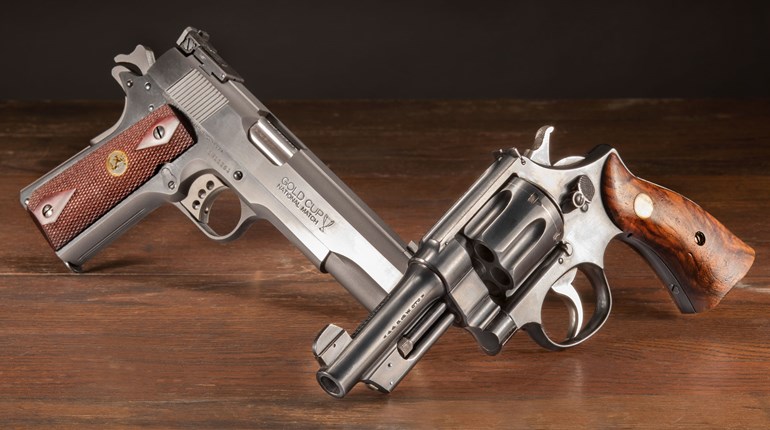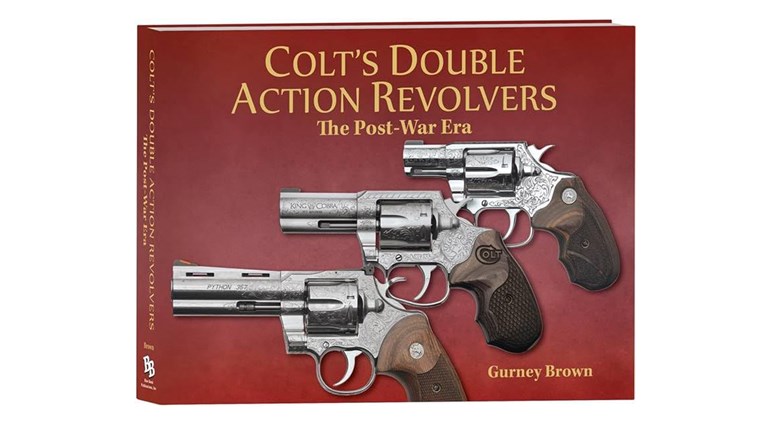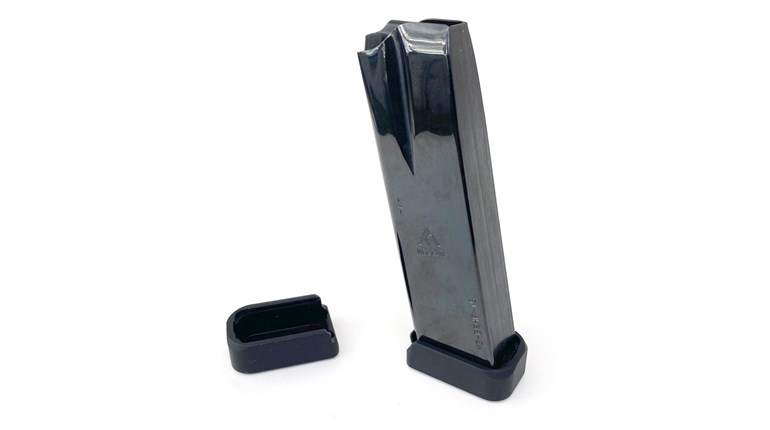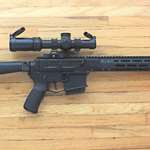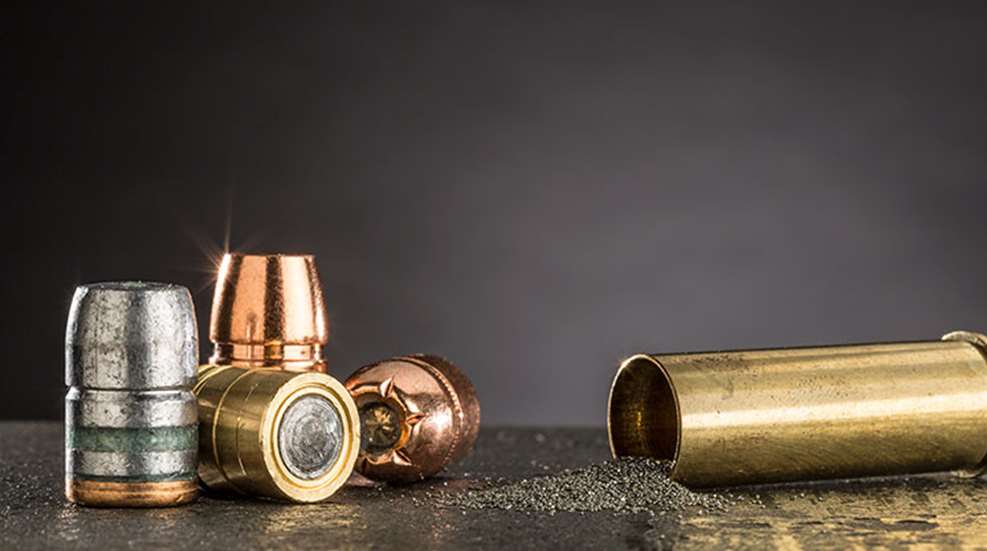
The initial shots evidently didn’t get it done, much to the chagrin of our guide who had a look of disbelief on his face as he muttered something incoherent under his breath. If we let the bull stiffen up a while we would more than likely find him lifeless inside a nearby stand of trees, which would have been the prudent approach. Our guide was contemplating (maybe even dreading) the follow-up when he realized that I, of more exuberance than brains, had gone headlong into the stand of trees just beyond the high grass in hot pursuit of the wounded 1,600-pound water buffalo—the one that had parted the brush like a slate-gray locomotive with horns.
That damn stand of trees. My hunting partner in this venture, Jack Huntington, showing much more restraint than me, had paused to gather himself before taking the plunge into the darkness ahead. He snapped out of his reverie as my hasty pursuit of the fleeing bovine prompted him to act, not knowing what was unfolding in the shadows.
My chase wasn’t logical, but I got caught up in the moment. Hey, I had started this and, by God, one way or another I was going to finish it. Would the buffalo make a stand? I was about to find out.
I burst through the first layer of scrub, moving at a clipped pace around the impenetrable stuff while my eyes tried to adjust to the rapidly fading light. I didn’t go far before I spotted the old warrior. No, he wasn’t running away anymore. He was stiffly standing there facing me, clearly prepared for this inevitable clash. His labored breath and dull, black eyes emanated sheer contempt. If only looks could kill.
I didn’t give him a chance to run me down before I hit him with 400 grains of attitude correction from my big revolver at the point of his shoulder. He shuddered, and just to my left Jack let 425 grains fly into the chest of the bull. (It was good to see Jack abandon prudence and come to my aid!) We both unloaded what remained in our five-shot revolvers into the dying bovine as it crashed to the Texas earth. And then it was time to get the carcass over to the skinning shed to see what kind of damage our bullets had done.
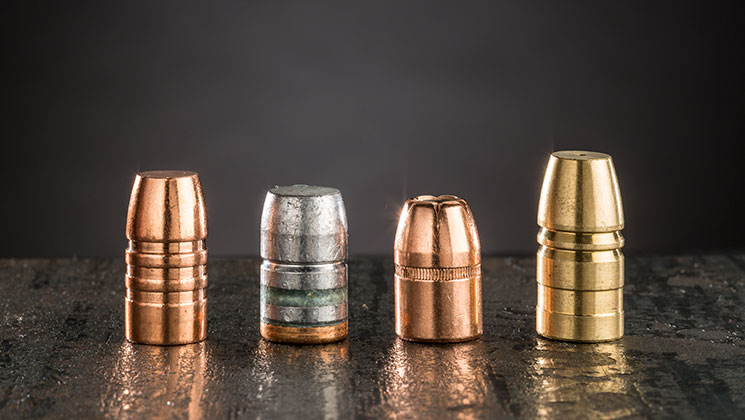
Size Matters
Jack Huntington and I used revolvers chambered for the .500 JRH on that outing, a cartridge he developed that is available in loaded form from Buffalo Bore Ammunition. Magnum Research manufactures production revolvers for this cartridge. In essence it is a .500 Smith & Wesson Magnum that has been cut down from 1.6 to 1.4 inches and comfortably slings 440-grain bullets at more than 1400 fps.
In the realm of hunting really large animals with a handgun, the old cliché “bigger is better” does hold true. This assertion comes with a number of caveats attached, which we will address.
Loaded properly (this is caveat No. 1), a big-bore revolver offers penetration in surplus: big holes result from big bullets by default. So, bigger is better on a big animal as long as it doesn’t compromise the shooter’s ability to direct the bullet accurately.
Let us define “big” as it pertains to this discussion: we are talking about animals that routinely tip the scales at 1,000 pounds-plus. Examples include moose, American bison, brown bear, water buffalo, Cape buffalo and several other African game animals. Bigger is better particularly when one factors in the inherent limitations of the revolver as a hunting platform. The revolver doesn’t have a high velocity potential, so we have to rely on and exploit all of the trickery available to us.
Here, trickery is defined as:
- Large bullet diameter—in this context .40 caliber and up; keep in mind .30 caliber is accepted worldwide for large game, and .375 is a minimum in many African nations for dangerous game. The .41 Magnum, .44 Magnum, .45 Colt, .454 Casull, .480 Ruger, .475 Linebaugh, .500 JRH, .500 Smith & Wesson Magnum, etc., are all examples of big-bore cartridges capable of cleanly taking the largest of game.
- Heavy weight-for-caliber bullets—momentum is a byproduct of heavy bullet weight.
- Bullet nose profile/shape—expansion is not necessary when the bullet comes “pre-expanded”: a wide, flat meplat (nose) creates a larger wound channel than the bullet diameter would lead you to believe and also delivers uncompromisingly stable, straight-line penetration.
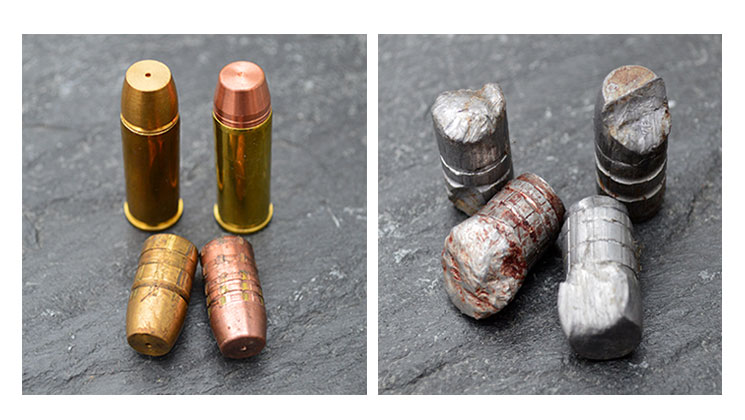
Don't Load Them Like Rifles
Let me put this up front: Attempts to turn revolvers into rifles by loading light bullets on top of maximum powder charges usually fall short on big game—not a situation you want to find yourself in when hunting any animal capable of bringing a fight to you. Handguns do not have the necessary physical attributes of a rifle to achieve rifle-like velocities; therefore, they cannot be loaded the way a rifle is loaded. We need to approach terminal ballistics a bit differently.
With the advent of quality bonded and monometal expanding and solid bullet designs, rifle calibers that were once deemed inadequate became real, live, viable big-game cartridges overnight. But bigger is still better with regards to handguns. Revolver cartridges have also improved with quality bullets, but the difference is in the dynamics. Whereas smaller, much higher-velocity projectiles from rifles benefit from expansion, revolver bullets, held to more subdued speeds by design parameters, benefit from straight and deep penetration—no expansion necessary, thank you very much. With the proper bullet, the big-bore revolver is already making a big hole, but the correct nose profile will ensure that big hole is also a deep hole.
There are basically two types of bullets in use by handgun hunters: those that expand and those that do not by design. To further break this down, when we talk about expanding bullets we are usually referring to jacketed soft-nose or hollow-point bullets, or monometal expanding bullets. Non-expanding bullets are hardcast lead solids, as well as a number of high-quality jacketed and monometal bullets designed for deep penetration.
Hardcast bullets derive their name from the composition of the alloy as well as the hardening process they are subjected to (water-quenching or heat-treating) after casting, which enables them to maintain their shape even when striking hard objects like bones. Some jacketed and monometal non-expanding bullets are more resistant to deformation than even a hardened lead bullet, and are better able to withstand high velocities and impacts with hard surfaces.
There are many jacketed and monometal expanding bullets available to the handloader that are also offered in factory-loaded ammunition in popular handgun calibers. Of particular quality are the Swift A-Frame and Barnes XPB. The preference is a stoutly constructed bullet that will not over-expand upon striking game. While violent expansion works well on thin-skinned game such as deer, you don’t want a bullet that expands at the expense of penetration. The net effect is like a parachute that rapidly slows the bullet and substantially inhibits penetration. I think many of us agree that two holes are better than one. There is a very fine line between enough expansion and adequate penetration.
The most reliable performers in the non-expanding category are flat-nosed jacketed bullets like the Rintoul Enterprises Kodiak Punch and Barnes Buster, and the monometal Cutting Edge Handgun Solid and Lehigh Shredder Tip Solid. Each has a blunt meplat that crushes and tears tissue, creating a much larger wound channel than the original diameter of the bullet.
Flat-nosed hardcast bullets can also be used, though in my humble opinion they do not offer the absolute reliability of non-expanding jacketed and monometal bullets. Their performance on big animals depends on a number of factors such as alloy and hardness. Hardcast bullets are popular with savvy handgun hunters and provide an economical alternative with typically adequate penetrative ability due to their resistance to expansion. However, there are limitations to the bullet material, which can be exceeded depending on impact velocity and what the bullet contacts along its path through an animal, such as heavy bone. Keeping velocities at moderate levels helps maintain the integrity of the bullet nose, aiding in penetration.
But all flat-nosed bullets aren’t created equally. Many feature a rather narrow meplat. A wide meplat not only creates a larger wound channel, but also helps the bullet stabilize in flesh and thereby penetrate in a straight line. What is a large meplat? We have found that between 75 and 80 percent of the overall bullet diameter seems to be optimal. With a meplat that’s less than 70 percent of the bullet diameter, wound channel size is compromised, as is stability. A small or narrow meplat can cause a flat-nosed bullet to tumble like a round-nose in flesh or to veer off course, not only inhibiting penetration but also decreasing the likelihood of the projectile going straight through the vitals.
When choosing a bullet or factory load, bullet weight must be taken into consideration. Light-for-caliber bullets, while able to achieve impressive velocities, do not possess the momentum or penetrative ability of heavy-for-caliber bullets, all else being equal. Bullets for big animals should follow these guidelines: .41 Magnum, 230-265 grains; .44 Magnum, 265-340 grains; .45 Colt/.454 Casull/.460 Smith & Wesson Magnum, 300-400 grains; .480 Ruger/.475 Linebaugh, 400 grains plus; .500 S&W Magnum/.500 Linebaugh/.500 JRH/.500 Wyoming Express, 440 grains plus.
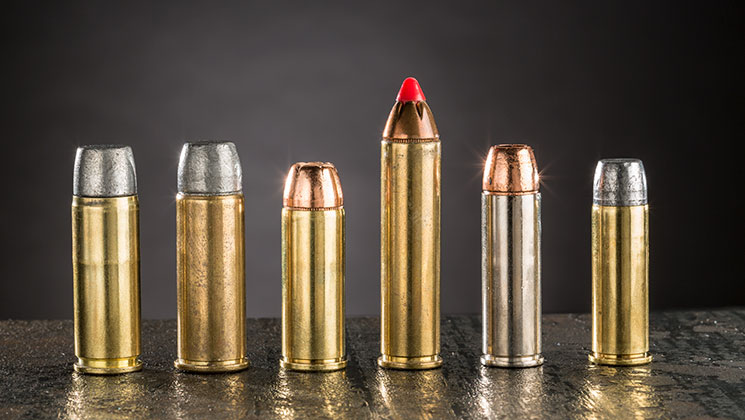
Forget Muzzle Energy
With the proper bullet and load, a big-bore revolver on big game doesn’t give up much, if anything, to accepted big-game rifles, except range. Paper ballistics be damned. There, I said it. Holes through vitals kill animals, and muzzle energy sells ammunition. Muzzle energy is a poor measure of lethality and is useful only to marketing experts.
“Heresy!” you say. “How can this be when rifle rounds are so much more powerful? Surely a big-game rifle is more effective on large animals.” I will answer that with “yes” and “no.” Before you string me up, listen to the voice of reason here.
In recent years, rifle hunters have embraced the concept of the flat-nosed solid for uncompromising straight-line penetration in big and dangerous game—something handgun hunters have known for decades. We typically get more than enough penetration to kill even the largest of animals with big-bore handguns by using these flat-nosed bullets at considerably lower velocities than, let’s say, a .458 Lott. While this rifle round will certainly impart a measured quantity of shock to the animal, holes through vitals kill. Also, regarding the mythical “stopping power,” the only reliable stop is a hit to the central nervous system, which depends more on shot placement than anything else, assuming the bullet penetrates straight and deep enough.
Is a big-bore revolver big-game medicine? Emphatically yes, in the right hands. Keep in mind the amount of dedication to the craft required of the handgun hunter is exponentially greater than that of the rifle hunter. That is just a cold, hard fact. However, when a properly loaded big-bore revolver is in skilled hands, no wild bovine or any other animal is safe. As long as shot placement is true, and the caliber/bullet/load combination exhibits enough penetration to get to and through the vitals, a dead animal will ensue. Bigger is better, as long as you do your part.
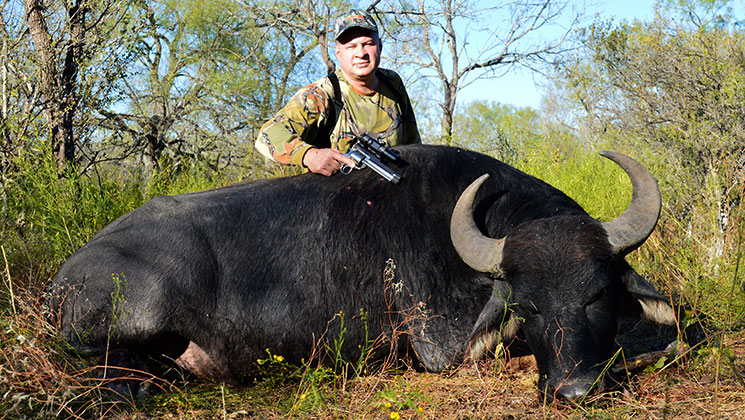
■ ■ ■
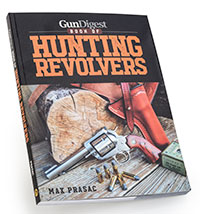 Max Prasac is the author of the Gun Digest Book of Hunting Revolvers. It’s a fresh take on a pastime that has been practiced for generations, and it’s organized into three main concepts: the principles of handgun hunting, the equipment necessary and the capabilities of several caliber offerings among the selection of hunting handguns available today. Anecdotes and pictures throughout the work detail the use of revolvers in hunting camps around the globe from North America to South America and Africa. $25.49; gundigeststore.com.
Max Prasac is the author of the Gun Digest Book of Hunting Revolvers. It’s a fresh take on a pastime that has been practiced for generations, and it’s organized into three main concepts: the principles of handgun hunting, the equipment necessary and the capabilities of several caliber offerings among the selection of hunting handguns available today. Anecdotes and pictures throughout the work detail the use of revolvers in hunting camps around the globe from North America to South America and Africa. $25.49; gundigeststore.com.












